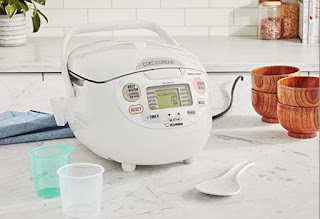In all of my years of cooking, I've always made my rice in a sauce pan. But twice in the last 2 weeks I had two attempts go bad. A batch of basmati rice was overcooked and really dry. Then I undercooked a batch of sticky rice. So I decided to do some research on rice cookers.
Rice cookers are ubiquitous in Japan. It is the most important appliance in every household. That's because rice is the most important food in Japan. Not only is it served with every meal....I learned it's the main course of every meal. The protein and veggies are simply side dishes to the rice.
In Japan, rice cookers serve 2 important purposes. First and foremost, a rice cooker means that every grain of rice is perfectly cooked....every time. Second, rice cookers are capable of holding the cooked rice at the perfect serving temperature for 12+ hours. Make one giant batch of rice in the morning and you have perfect, hot rice available for every meal of the day.
Japanese consumers can choose from hundreds of models. Each family is so dependent on their rice cookers, that the retail centers host a huge number of stores that specialize in rice cooker repairs. If your rice cooker is broken, you bring it in to the repair store and they give you a loaner to use until yours is fixed. It is unthinkable that any Japanese family would have to go without their rice cooker for a few days.
After many days of extensive research, I purchased a Zojirushi Ns-Zcc10 5-1/2 Cup Neuro Fuzzy Rice Cooker And Warmer. The company is over 100 years old and their rice cookers are considered the gold standard. They are also one of the few Japanese rice cooker manufacturers that make rice cookers for markets outside of Japan. While they offer a whole range of rice cookers, some of which cost over $2,000, I got mine from Amazon for $187.
- Place steak in a bowl with the 1/4 cup of cornstarch, 2 tablespoons soy sauce, a little salt and pepper. Mix well and set aside.
- Combine remaining 3 tablespoons of soy sauce, hoisin sauce, chili oil, brown sugar, 1 tablespoon corn starch and broth. Mix well and set aside.
- Heat a couple of tablespoons of oil in a wok (or large pan) over high heat.
- Cook the steak in batches...each batch should be comprised of a singe layer of steak. Cook each batch for 2 minutes per side until the steak is a deep golden brown. As each batch is cooked, place in a bowl.
- When steak is all done, add oil to the empty wok and cook red pepper and onion until they just start to soften (about 3 minutes). Then add red pepper flakes and peppercorns. Stir to mix well.
- Add garlic and ginger to the wok. Stir until fragrant, then add beef back to the wok with any juices.
- Sir to mix, then add the sauce. Stir for 30 seconds, then serve.





No comments:
Post a Comment